英美文学中的戏剧drama
世界戏剧 中文英语双语介绍
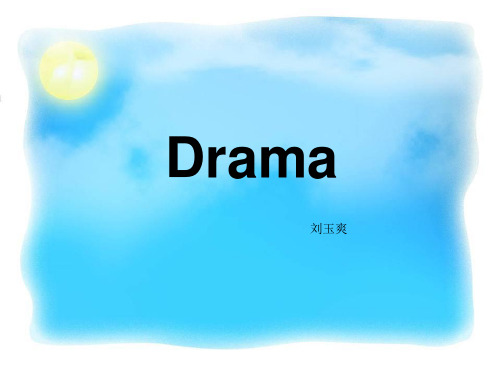
(一 八九 九 ~ 一九 六六 )
Lao She (1899-1966), real name Shu Qingchun, was of Manchurian descent and the famous novelist, litterateur and dramatist. (老舍,原名舒庆春,字舍予,笔名老舍。北京满族 正红旗人,中国现代著名小说家、文学家、戏剧家。)
结局是故事的结论。喜剧结束,主角比在故事的 开端有更好的结果。悲剧结束在灾难中,主角是 不如在故事的开始。更现代的作品可能并没有结 局而是展现一个快速的或令人惊讶的结尾。
《茶馆》
1 2
This is one of the famous dramas by Lao She. The drama is set in a typical, old Beijing teahouse and follows the lives of the owner and his customers through three stages in modern Chinese history. (这是一部老舍写的很有名的话剧。话剧的场景设在一个典型的 老北京茶馆里,描述了店家和喝茶人分布在现代中国历史上三个 阶层的生活。)
the city-state of Athens produced three genres of drama: tragedy, comedy, and the satyr play(【古希腊】森林之神滑稽短歌剧, 萨堤罗斯滑稽剧).
西方戏剧起源于古希腊。雅典城邦的 戏剧文化产生 了三个剧种:悲剧,喜剧, 和羊人剧。。
《茶馆》
1 2
Click to add title in here Click to add title in here Click to add title in here
英美文学之文学术语

英美文学之文学术语文学术语汇编11.Literature of the absurd: (荒诞派文学) The term is applied to a number of works in drama and prose fiction which have in common the sense that the human condition is essentially absurd, and that this condition can be adequately represented only in works of literature that are themselves absurd. The current movement emerged in France after the Second World War, as a rebellion against essential beliefs and values of traditional culture and traditional literature. They hold the belief that a human being is an isolated existent who is cast into an alien universe and the human life in its fruitless search for purpose and meaning is both anguish and absurd.2.Theater of the absurd: (荒诞派戏剧) belongs to literature of the absurd. Two representatives of this school are Eugene Ionesco, French author of The Bald Soprano (1949) (此作品中文译名<秃头歌女>), and Samuel Beckett, Irish author of Waiting for Godot (1954) (此作品是荒诞派戏剧代表作<等待戈多>). They project the irrationalism, helplessness and absurdity of life in dramatic forms that reject realistic settings, logical reasoning, or a coherently evolving plot.3.Black comedy or black humor: (黑色幽默) it mostly employed to describe baleful, naïve, or inept characters in a fantastic or nightmarish modern world playing out their roles in what Ionesco called a “tragic farce”, in which the events are often simultaneously comic, horrifying, and absurd. Joseph Heller’s Catch-22 (美国著名作家约瑟夫海勒<二十二条军规>) can be taken as an example of the employment of this technique.文学术语汇编24. Aestheticism or the Aesthetic Movement(唯美主义): it began to prevail in Europe at the middle of the 19th century. The theory of “art for art’s sake” was first put forward by some French artists. They declared that art should serve no religious, moral or social purpose. The two most important representatives of aestheticists in English literature are Walt Pater and Oscar Wilde.5. Allegory(寓言): a tale in verse or prose in which characters, actions, or settings represent abstract ideas or moral qualities, such as John Bunyan’s The Pilgrim’s Progress. An allegory is a story with two meanings, a literal meaning and a symbolic meaning.6. Fable(寓言): is a short narrative, in prose or verse, that exemplifies an abstract moral thesis or principle of human behavior. Most common is the beast fable, in which animals talk and act like the human types they represent. The fables in Western cultures derive mainly from the stories attributed to Aesop, a Greek slave of the sixth century B. C.7. Parable(寓言): is a very short narrative about human beings presented so as to stress analogy with a general lesson that the narrator is trying to bring home to his audience. For example, the Bible contains lots of parables employed by Jesus Christ to make his flock understand his preach.(注意以上三个词在汉语中都翻译成语言,但是内涵并不相同,不要搞混)8. Alliteration(头韵): the repetition of the initial consonant sounds. In Old English alliterative meter, alliteration is the principal organizing device of the verse line, such as in Beowulf.9. Consonance is the repetition of a sequence of two or more consonants but with a change in the intervening vowel, such as “live and love”.10. Assonance is the repetition of identical or similar vowel, especially in stressed syllables, in a sequence of nearby words, such as “child of silence”.11. Allusion (典故)is a reference without explicit identification, to a literary or historical person, place, or event, or to another literary work or passage. Most literary allusions are intended to be recognized by the generally educated readers of the author’s time, but some are aimed at a special group.12. Ambiguity(复义性): Since William Empson(燕卜荪)published Seven Types of Ambiguity(《复义七型》), the term has been widely used in criticism to identify a deliberate poetic device: the use of a single word or expression to signify two or more distinct references, or to express two or more diverse attitudes or feeling.文学术语汇编313. Antihero(反英雄):the chief character in a modern novel or play whose character is totally different from the traditional heroes. Instead of manifesting largeness, dignity, power, or heroism, the antihero is petty, passive, ineffectual or dishonest. For example, the heroine of Defoe’s Moll Flanders is a thief and a prostitute.14. Antithesis(对照):(a figure of speech)An antithesis is often expressed in a balanced sentence, that is, a sentence in which identical or similar syntactic structure is used to express contrasting ideas. For example, “Marriage has many pains, but celibacy(独身生活)has no pleasures.” by Samuel Johnson obviously employs antithesis.15. Archaism(拟古):the literary use of words and expressions that have become obsolete in the common speech of an era. For example, the translators of the King James Version of Bible gave weight and dignity to their prose by employing archaism.16. Atmosphere(氛围): the prevailing mood or feeling of a literary work. Atmosphere is often developed, at least in part, through descriptions of setting. Such descriptions help to create an emotional climate to establish the reader’s expectations and attitudes.文学术语汇编417. Ballad(民谣):it is a song, transmitted orally, which tells a story. It originated and was communicated orally among illiterate or only partly literate people. It exists in many variant forms. The most common stanza form, called ballad stanza is a quatrain in alternate four- and three-stress lines; usually only the second and fourth lines rhyme. Although many traditional ballads probably originated in the late Middle Age, they were not collected and printed until the eighteenth century.18. Climax:as a rhetorical device it means an ascending sequence of importance. As a literary term, it can also refer to the point of greatest intensity, interest, or suspense in a story’s turning point. The action leading to the climax and the simultaneous increaseof tension in the plot are known as the rising action. All action after the climax is referred to as the falling action, or resolution. The term crisis is sometimes used interchangeably with climax.19. Anticlimax(突降):it denotes a writer’s deliberate drop from the serious and elevated to the trivial and lowly, in order to achieve a comic or satiric effect. It is a rhetorical device in English.20. Beat Generation(垮掉一代):it refers to a loose-knit group of poets and novelists, writing in the second half of the 1950s and early 1960s, who shared a set of social attitudes – antiestablishment, antipolitical, anti-intellectual, opposed to the prevailing cultural, literary, and moral values, and in favor of unfettered self-realization andself-expression. Representatives of the group include Allen Ginsberg, Jack Kerouac and William Burroughs. And most famous literary creations produced by this group should be Allen Ginsberg’s long poem Howl and Jack Kerouac’s On the Road.文学术语汇编521. Biography(传记):a detailed account of a person’s life written by another person, such as Samuel Johnson’s Lives of the English Poets and James Boswell’s Life of Samuel Johnson.22. Autobiography(自传):a person’s account of his or her own life, such as Benjamin Franklin’s autobiography.23. Blank verse(无韵体): Verse written in unrhymed iambic pentameter. It is the verse form used in some of the greatest English poetry, including that of William Shakespeare and John Milton.24. A parody(模仿)imitates the serious manner and characteristic features of a particular literary work, or the distinctive style of a particular author, or the typical stylistic and other features of a serious literary genre, and deflates the original by applying the imitation to a lowly or comically inappropriate subject.文学术语汇编625. Celtic Revival also known as the Irish Literary Renaissance (爱尔兰文艺复兴)identifies the remarkably creative period in Irish literature from about 1880 to the death of William Butler Yeats in 1939. The aim of Yeats and other early leaders of the movement was to create a distinctively national literature by going back to Irish history, legend, and folklore, as well as to native literary models. The major writers of this movement include William Butler Yeats, Lady Gregory, John Millington Synge and Sean O’Casey and so on.26. Characters(人物)are the persons represented in a dramatic or narrative work, who are interpreted by the reader as being endowed with particular moral, intellectual, and emotional qualities by inferences from the dialogues, actions and motivations. E. M. Forster divides characters into two types: flat character, which is presented without much individualizing detail; and round character, which is complex in temperament and motivation and is represented with subtle particularity.27. Chivalric Romance (or medieval romance) (骑士传奇或中世纪传奇)is a type of narrative that developed in twelfth-century France, spread to the literatures of other countries. Its standard plot is that of a quest undertaken by a single knight in order to gain a lady’s favor; frequently its central interest is courtly love, together with tournaments fought and dragons and monsters slain. It stresses the chivalric ideals of courage, loyalty, honor, mercifulness to an opponent, and elaborate manners.28. Comedy:(喜剧)in general, a literary work that ends happily with a healthy, amicable armistice between the protagonist and society.29. Farce (闹剧)is a type of comedy designed to provoke the audience to simple and hearty laughter. To do so it commonly employs highly exaggerated types of characters and puts them into improbable and ludicrous situations.30. Confessional poetry(自白派诗歌)designates a type of narrative and lyric verse, given impetus by Robert Lowell’s Life Studies, which deals with the facts and intimate mental and physical experiences of the poet’s own life. Confessional poetry was written in rebellion against the demand for impersonality by T. S. Elliot and the New Criticism. The representative writers of confessional school include Robert Lowell, Anne Sexton and Sylvia Plath and so on.31. Critical Realism:(批判现实主义)The critical realism of the 19th century flourished in the fouties and in the beginning of fifties. The realists first and foremost set themselves the task of criticizing capitalist society from a democratic viewpoint and delineated the crying contradictions of bourgeois reality. But they did not find a way to eradicate social evils. Representative writers of this trend include Charles Dickens and William Makepeace Thackeray and so on.32. Drama:(戏剧)The form of composition designed for performance in the theater, in which actors take the roles of the characters, perform the indicated action, and utter the written dialogue. (The common alternative name for a dramatic composition is a play.)文学术语汇编733. Dramatic Monologue:(戏剧独白)a monologue is a lengthy speech by a single person. Dramatic monologue does not designate a component in a play, but a type of lyric poem that was perfected by Robert Browning. By using dramatic monologue, a single person, who is patently not the poet, utters the speech that makes up the whole of the poem, in a specific situation at a critical moment. For example, Robert Browning’s famous poem “My Last Duchess” was written in dramatic monologue. 34. Elegy(哀歌或挽歌):a poem of mourning, usually over the death of an individual. An elegy is a type of lyric poem, usually formal in language and structure, and solemn or even melancholy in tone.35. Enlightenment(启蒙运动):The name applied to an intellectual movement which developed in Western Europe during the seventeenth century and reached its height in the eighteenth. The common element was a trust in human reason as adequate to solve the crucial problems and to establish the essential norms in life, together with the belief that the application of reason was rapidly dissipating the remaining feudal traditions. It influenced lots of famous English writers especially those neoclassic writers, such as Alexander Pope.36. Epic(史诗):it is a long verse narrative on a serious subject, told in a formal and elevated style, and centered on a heroic or quasi-divine figure on whose actions depends the fate of a tribe, a nation, or the human race.37. Epiphany:(顿悟)In the early draft of A Portrait of the Artist as a Young Man, James Joyce employed this term to signify a sudden sense of radiance and revelation that one may feel while perceiving a commonplace object. “Epiphany” now has become the standard term for the description, frequent in modern poetry and prose fiction, of the sudden flare into revelation of an ordinary object or scene.38. Epithet(移就): as a term in criticism, epithet denotes an adjective or adjectival phrase used to define a distinctive quality of a person or thing. This method was widely employed in ancient epics. For example, in Homer’s epic, the epithet like “the wine-dark sea” can be found everywhere.39. Essay:(散文)any short composition in prose that undertakes to discuss a matter, express a point of view, persuade us to accept a thesis on any subject, or simply entertain. The essay can be divided as the formal essay and the informal essay (familiar essay).40. Euphemism(委婉语): An inoffensive expression used in place of a blunt one that is felt to be disagreeable or embarrassing, such as “pass away” instead of “die”41. Expressionism(表现主义):a German movement in literature and the other arts which was at its height between 1910 and 1925 – that is, in the period just before, during, and after WWⅠ. The expressionist artist or writer undertakes to express a personal vision – usually a troubled or tensely emotional vision – of human life and human society. This is done by exaggerating and distorting. We recognize its effects, direct or indirect, on the writing and staging of such plays as Arthur Miller’s Death ofa Salesman as well as on the theater of the absurd.42. Free verse(自由体诗):Like traditional verse, it is printed in short lines instead of with the continuity of prose, but it differs from such verse by the fact that its rhythmic pattern is not organized into a regular metrical form – that is, into feet, or recurrent units of weak and strong stressed syllables. Most free verse also hasirregular line lengths, and either lacks rhyme or else uses it only occasionally. Walt Whitman is a representative who employed this poem form successfully.文学术语汇编843. Gothic novel:(哥特式小说)It is a type of prose fiction. The writers of this type of fictions mostly set their stories in the medieval period and in a Catholic country, especially Italy or Spain. The locale was often a gloomy castle. The typical story focused on the sufferings imposed on an innocent heroine by a cruel villain. This type of fictions made bountiful use of ghosts, mysterious disappearances, and other supernatural occurrences. The principle aim of such novels was to evoke chilling terror and the best of this type opened up to the fiction the realm of the irrational and of the perverse impulses and nightmarish terrors that lie beneath the orderly surface of the civilized mind. Some famous novelists liked to employ some Gothic elements in their novels, such as Emily Bronte’s Wuthering Heights.44. Graveyard poets(墓园派诗歌): A term applied to eighteenth-century poets who wrote meditative poems, usually set in a graveyard, on the theme of human mortality, in moods which range from pensiveness to profound gloom. The vogue resulted in one of the most widely known English poems, Thomas Gray’s“Elegy Written in a Country Churchyard”.45. Harlem Renaissance(哈莱姆文艺复兴):a period of remarkable creativity in literature, music, dance, painting, and sculpture by African-Americans, from the end of the First World War in 1917 through the 1920s. As a result of the mass migrations to the urban North in order to escape the legal segregation of the American South, and also in order to take advantage of the jobs opened to African Americans at the beginning of the War, the population of the region of Manhattan known as Harlem became almost exclusively Black, and the vital center of African American culture in America. Distinguished writers who were part of the movement included Langston Hughes and Jean Toomer. The Great Depression of 1929 and the early 1930s broughtthe period of buoyant Harlem culture – which had been fostered by prosperity in the publishing industry and the art world – effectively to an end.46. Heroic Couplet(英雄双韵体)refers to lines of iambic pentameter which rhyme in pairs: aa, bb, cc, and so on. The adjective “heroic” was applied in the later seventeenth century because of the frequent use of such couplets in heroic poems and dramas. This verse form was introduced into English poetry by Geoffrey Chaucer. From the age of John Dryden through that of Samuel Johnson, the heroic couplet was the predominant English measure for all the poetic kinds; some poets, including Alexander Pope, used it almost to the exclusion of other meters.47. Hyperbole(夸张):this figure of speech called hyperbole is bold overstatement, or the extravagant exaggeration of fact or of possibility. It may be used either for serious or ironic or comic effect.48. Understatement(轻描淡写):this figure of speech deliberately represents something as very much less in magnitude or importance than it really is, or is ordinarily considered to be. The effect is usually ironic.49. Imagism(意象派):it was a poetic vogue that flourished in England, and even more vigorously in America, between the years 1912 and 1917. It was planned and exemplified by a group of English and American writers in London, partly under the influence of the poetic theory of T. E. Hulme, as a revolt against the sentimental and mannerish poetry at the turn of the century. The typical Imagist poetry is written in free verse and undertakes to be as precisely and tersely as possible. Meanwhile, the Imagist poetry likes to express the writers’ momentary impression of a visual object or scene and often the impression is rendered by means of metaphor without indicating a relation. Most famous Imagist poem, “In a Station of the Metro”, was written by Ezra Pound. Imagism was too restrictive to endure long as a concerted movement, but it influenced almost all modern poets of Britain and America.50. Irony(反讽):This term derives from a character in a Greek comedy. In most of the modern critical uses of the term “irony”, there remains the root sense of dissembling or hiding what is actually the case; not, however, in order to deceive, but to achieve rhetorical or artistic effects.51. Local Colorism(地方色彩)was a literary trend belonging to Realism. It refers to the detailed representation in prose fiction of the setting, dialect, customs, dress and ways of thinking and feeling which are distinctive of a particular region. After the Civil War a number of American writers exploited the literary possibilities of local color in various parts of America. The most famous representative of local colorism should be Mark Twain who took his hometown near the Mississippi as the typical setting of nearly all his novels.52. Lyric(抒情诗):in the most common use of the term, a lyric is any fairly short poems consisting of the utterance by a single speaker, who expresses a state of mind or a process of perception, thought and feeling.。
戏剧(drama)
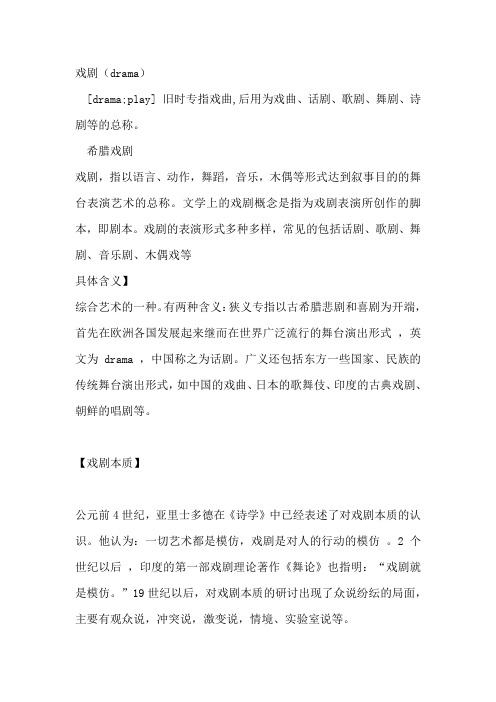
戏剧(drama)[drama;play] 旧时专指戏曲,后用为戏曲、话剧、歌剧、舞剧、诗剧等的总称。
希腊戏剧戏剧,指以语言、动作,舞蹈,音乐,木偶等形式达到叙事目的的舞台表演艺术的总称。
文学上的戏剧概念是指为戏剧表演所创作的脚本,即剧本。
戏剧的表演形式多种多样,常见的包括话剧、歌剧、舞剧、音乐剧、木偶戏等具体含义】综合艺术的一种。
有两种含义:狭义专指以古希腊悲剧和喜剧为开端,首先在欧洲各国发展起来继而在世界广泛流行的舞台演出形式,英文为drama ,中国称之为话剧。
广义还包括东方一些国家、民族的传统舞台演出形式,如中国的戏曲、日本的歌舞伎、印度的古典戏剧、朝鲜的唱剧等。
【戏剧本质】公元前4世纪,亚里士多德在《诗学》中已经表述了对戏剧本质的认识。
他认为:一切艺术都是模仿,戏剧是对人的行动的模仿。
2个世纪以后,印度的第一部戏剧理论著作《舞论》也指明:“戏剧就是模仿。
”19世纪以后,对戏剧本质的研讨出现了众说纷纭的局面,主要有观众说,冲突说,激变说,情境、实验室说等。
观众说:认定观众是戏剧的必要条件,也是戏剧的本质所在。
法国戏剧理论家F.萨赛是这种观念的代表,他断言:不管是什么样的戏剧作品,都是为了给观众看的。
“没有观众,就没有戏剧”,因而,戏剧的一切器官都必须与观众的欣赏相适应。
冲突说:以法国戏剧理论家布伦退尔为代表。
19世纪末,布伦退尔指出:舞台乃是人的自觉意志发挥的场所,人物的自觉意志的发挥必定会遇到阻碍,主体为克服阻碍就要与之斗争,这就构成“意志冲突”,戏剧的本质就在于此。
美国戏剧理论家J.H.劳森则把戏剧的本质归之为“自觉意志在其中发挥作用的社会性冲突”。
他认为:由于戏剧是处理社会关系的,而人的自觉意志又必须受社会必然性的制约,因而,真正的戏剧性冲突必须是社会性冲突。
这种观念可以一句话来表述:“没有冲突就没有戏剧。
”激变说:英国戏剧理论家W.阿契尔否定布伦退尔的“冲突”说,他把小说与戏剧相比较,认为小说是“渐变”的艺术,而戏剧是“激变”( crisis ,又译危机 )的艺术,戏剧所处理的是人的命运和环境的一次激变,这就是戏剧本质的所在。
英美文学常识(戏剧)Drama

stage right
downstage
stage left
Setting the Stage
Scene design transforms a bare stage into the world of the play. Scene design consists of
• sets • lighting
Props (short for properties) are items that the characters carry or handle onstage.
• The person in charge of props must make sure that the right props are available to the actors at the right moments.
Drama
What Is Drama?
What makes Drama different from other forms of literature (fiction, poetry)? Name some of the differences by providing particular aspects about drama. For example: Actors, audience, stage, setting, lighting, music…
Practice II
ALPHABET Conversation Have a conversation where each sentence begins with the next letter of the alphabet. Here is an example: A: Anyone seen my cat? B: Black one, with funny eyes? A: Can't say I remember. B: Don't tell me you've forgotten what it looks like? A: Every cat looks the same to me. B: Fortunately, I found one yesterday A: Gee, that's great!
话剧、喜剧小品的历史、赏析

一、什么是戏剧 drama:剧本,剧本文学(强调文学) theatre:剧场中表演的戏剧(强调剧场)(shanghai theatre academy) 1、定义:是演员在舞台上扮演角色,当众表演故事的一种艺 术形式。是以表演为中心的包含文学、音乐、舞蹈、美术等艺 术门类综合艺术。又称“舞台艺术”或“演员艺术”。 2、两个重要的概念: (1)戏剧冲突:戏剧作品中人与人之间或人的内心展开的矛 盾斗争。戏剧作品总是由一个或多个戏剧冲突的提出、发展、 解决而完成的。 (2)戏剧性:戏剧性是和戏剧冲突联系在一起的,戏剧性就 在于紧张、深刻的冲突矛盾,“没有冲突就没有戏剧性”。
《雷雨》(借鉴西方,自己创造) 1、题材:家庭剧——夫妻矛盾,父子冲突,母子兄妹乱伦、 劳工冲突等 2、主题:反封建,颂扬个性解放 3、结构(讲故事的方法)——锁闭式结构(俄狄浦斯王)把 三十多年的故事锁闭在一天之内叙述出来。 故事从“危机点”上开始讲述。蘩漪已经难以忍受周朴园, 周萍为了躲避她想到矿上去,蘩漪为了留住周萍请来四凤母亲。 随着鲁妈登场,导致了剧情走向高潮和悲剧结局。剧本将周鲁 两家长达30多年的纠葛,以及蘩漪和周萍关系的前因后果全部 集中在一天之内加以叙述。在表示蘩漪、周朴园和周萍这个当 前主要冲突的同时,将几组次要矛盾穿插其间。过去的戏和当 前的戏紧密交织在一起。人物前史逐步揭露,有力推动当前动 作的发展,使戏剧走向高潮。情节紧张曲折,冲突尖锐激烈。 4、人物: 蘩漪,半新半旧,母亲不像母亲、情人不像情人,雷雨性格 周朴园、周萍
《上海屋檐下》(契可夫《海鸥》、《樱桃园》,静剧) 1、小市民生活 2、横断面式结构:不是围绕一个完整故事、一对主要冲突展 开情节。而是同时描写5家故事,相互交织。杨彩玉、林志成、 匡复 3、很少表现人物直接、外在冲突,着重揭示人的内心世界。
elizabethan drama名词解释

Elizabethan drama是指16世纪英国伊丽莎白一世统治时期的戏剧作品和戏剧表演形式。
这一时期的戏剧创作和表演活动在英国戏剧史上具有重要意义,对后世英国戏剧和世界戏剧产生了深远的影响。
一、伊丽莎白一世时期伊丽莎白一世在位期间是英国文艺复兴的黄金时期,也是伟大的文学和戏剧作品层出不穷的时期。
在这个时期,戏剧成为了当时社会的一种主要文化娱乐活动,得到了贵族和平民的广泛关注和喜爱。
许多杰出的戏剧作家如莎士比亚、克里斯托弗·马洛、本·琼森等,都是在这一时期涌现出来的。
二、戏剧主题伊丽莎白时代的戏剧主题多样,既有历史剧,如莎士比亚的《理查三世》、《亨利四世》,又有喜剧,如《仲夏夜之梦》、《威尼斯商人》,还有诸如《奥赛罗》、《哈姆雷特》等悲剧。
这些戏剧作品涉及到政治、爱情、婚姻、家庭、名利等人类普遍关注的主题,体现了当时社会的多样性和矛盾性。
三、戏剧表演形式伊丽莎白时代的戏剧表演形式以剧场表演和宫廷表演为主。
剧场表演一般是在伦敦的剧院进行,如莎士比亚环球剧场、罗斯剧院等,这些剧院成为了当时戏剧表演的主要场所。
而宫廷表演则是在王宫内举行,是贵族和王室成员们的专场演出。
这两种表演形式共同构成了当时戏剧表演的主流。
四、戏剧艺术特点伊丽莎白时代的戏剧艺术具有鲜明的特点,包括:1. 语言丰富多彩,表现力强。
伊丽莎白时代的戏剧作品以其优美的语言和独特的表现形式著称,其中尤以莎士比亚的作品最为著名。
2. 剧情复杂,人物丰满。
伊丽莎白时代的戏剧作品在情节设置和人物塑造方面非常讲究,角色性格鲜明,情节曲折离奇。
3. 舞台布景精美,服装华丽。
当时的戏剧表演注重舞台效果和视觉效果,舞台布景和服装都非常精美,给人留下深刻的印象。
五、戏剧影响伊丽莎白时代的戏剧产生了深远的影响,不仅对英国戏剧史产生了重要影响,也对世界戏剧产生了一定的影响。
伊丽莎白时代的戏剧作品和表演形式在后世的戏剧创作和表演实践中仍然具有重要的地位,成为了后世戏剧艺术的宝贵遗产。
TEM8 英语专八英美文学
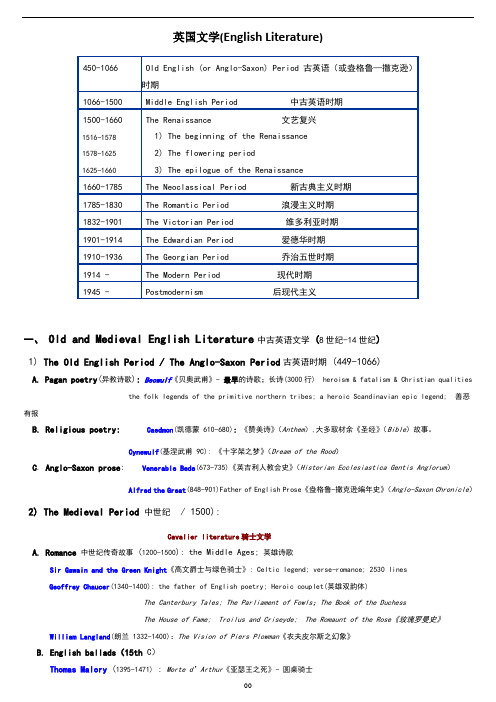
英国文学(English Literature)一、Old and Medieval English Literature中古英语文学(8世纪-14世纪)1) The Old English Period / The Anglo-Saxon Period古英语时期 (449-1066)A. Pagan poetry(异教诗歌): Beowulf《贝奥武甫》- 最早的诗歌;长诗(3000行) heroism & fatalism & Christian qualitiesthe folk legends of the primitive northern tribes; a heroic Scandinavian epic legend; 善恶有报B. Religious poetry:Caedmon(凯德蒙 610-680): 《赞美诗》(Anthem),大多取材余《圣经》(Bible)故事。
Cynewulf(基涅武甫 9C): 《十字架之梦》(Dream of the Rood)C. Anglo-Saxon prose: Venerable Bede(673-735)《英吉利人教会史》(Historian Ecclesiastica Gentis Anglorum)Alfred the Great(848-901)Father of English Prose《盎格鲁-撒克逊编年史》(Anglo-Saxon Chronicle)2) The Medieval Period中世纪 / 1500):Cavalier literature骑士文学A.Romance中世纪传奇故事 (1200-1500): the Middle Ages; 英雄诗歌Sir Gawain and the Green Knight《高文爵士与绿色骑士》: Celtic legend; verse-romance; 2530 linesGeoffrey Chaucer(1340-1400): the father of English poetry; Heroic couplet(英雄双韵体)The Canterbury Tales; The Parliament of Fowls;The Book of the DuchessThe House of Fame; Troilus and Criseyde; The Romaunt of the Rose《玫瑰罗曼史》William Langland(朗兰 1332-1400):The Vision of Piers Plowman《农夫皮尔斯之幻象》B.English ballads(15th C)Thomas Malory(1395-1471) :Morte d’Arthur《亚瑟王之死》- 圆桌骑士二、The Renaissance Period英国文艺复兴 (1500-1660):人文主义humanism; 十四行诗Sonnets; 无韵诗Blank verse; 戏剧Drama; 斯宾塞诗体Spenserian;University Wits 大学才子派1) 诗歌a. Thomas Wyatt(怀亚特1503-1542): the first to introduce the sonnet into English literatureb. Sir Philip Sidney(雪尼爵士 1554-1586):代表了当时的理想 - “the complete man”Defense of Poetry《为诗辩护》Astrophel and Stella《爱星者与星》;Arcadia《阿卡狄亚》: a prose romance filled with lyrics; a forerunner of the modern worldc. Edmund Spenser(斯宾塞1552-1599): the poets’ poetThe Shepherd Calendar《牧人日历》;Amoretti《爱情小唱》The Faerie Queen《仙后》:long poem for Queen Elizabeth; Allegory - nine-line verse stanza/ the Spenserian StanzaSpenserian Stanza(斯宾塞诗体): Nine lines, the first eight lines is in iambic(抑扬格) pentameter(五步诗),and the ninth line is an iambic hexameter(六步诗) line.2) 散文a. Thomas More(莫尔 1478-1535): 欧洲早期空想社会主义创始人Utopia《乌托邦》: More与海员的对话b. John Lyly (黎里 1553-160,散文家,剧作家&小说家):Eupheus《尤菲绮斯》Euphuism(夸饰文体): Abundant use of balanced sentences, alliterations(头韵) and other artificial prosodic(韵律) means.The use of odd similes(明喻) and comparisonsc. Francis Bacon (培根 1561-1626):Essays(论说文集):Of Studies, Of Love, Of Beauty: the first true English prose classicPhilosophical: New Instrument《新工具》New Atlantis《新大溪岛》Advancement of Learning《学术的推进》Professionals: Maxims of the Law《法律格言》3) 戏剧a. Christopher Marlowe: University Wits 大学才子派First made blank verse(无韵诗:不押韵的五步诗) the principle instrument of English dramaThe Jew of Malta《马耳他的犹太人》The Tragical History of Doctor Faustus《浮士德博士的悲剧》:根据德国民间故事书写成; 完善了无韵体诗。
戏剧(drama)

戏剧(drama)[drama;play] 旧时专指戏曲,后用为戏曲、话剧、歌剧、舞剧、诗剧等的总称。
希腊戏剧戏剧,指以语言、动作,舞蹈,音乐,木偶等形式达到叙事目的的舞台表演艺术的总称。
文学上的戏剧概念是指为戏剧表演所创作的脚本,即剧本。
戏剧的表演形式多种多样,常见的包括话剧、歌剧、舞剧、音乐剧、木偶戏等具体含义】综合艺术的一种。
有两种含义:狭义专指以古希腊悲剧和喜剧为开端,首先在欧洲各国发展起来继而在世界广泛流行的舞台演出形式,英文为drama ,中国称之为话剧。
广义还包括东方一些国家、民族的传统舞台演出形式,如中国的戏曲、日本的歌舞伎、印度的古典戏剧、朝鲜的唱剧等。
【戏剧本质】公元前4世纪,亚里士多德在《诗学》中已经表述了对戏剧本质的认识。
他认为:一切艺术都是模仿,戏剧是对人的行动的模仿。
2个世纪以后,印度的第一部戏剧理论著作《舞论》也指明:“戏剧就是模仿。
”19世纪以后,对戏剧本质的研讨出现了众说纷纭的局面,主要有观众说,冲突说,激变说,情境、实验室说等。
观众说:认定观众是戏剧的必要条件,也是戏剧的本质所在。
法国戏剧理论家F.萨赛是这种观念的代表,他断言:不管是什么样的戏剧作品,都是为了给观众看的。
“没有观众,就没有戏剧”,因而,戏剧的一切器官都必须与观众的欣赏相适应。
冲突说:以法国戏剧理论家布伦退尔为代表。
19世纪末,布伦退尔指出:舞台乃是人的自觉意志发挥的场所,人物的自觉意志的发挥必定会遇到阻碍,主体为克服阻碍就要与之斗争,这就构成“意志冲突”,戏剧的本质就在于此。
美国戏剧理论家J.H.劳森则把戏剧的本质归之为“自觉意志在其中发挥作用的社会性冲突”。
他认为:由于戏剧是处理社会关系的,而人的自觉意志又必须受社会必然性的制约,因而,真正的戏剧性冲突必须是社会性冲突。
这种观念可以一句话来表述:“没有冲突就没有戏剧。
”激变说:英国戏剧理论家W.阿契尔否定布伦退尔的“冲突”说,他把小说与戏剧相比较,认为小说是“渐变”的艺术,而戏剧是“激变”( crisis ,又译危机 )的艺术,戏剧所处理的是人的命运和环境的一次激变,这就是戏剧本质的所在。
英美文学常用术语及解释
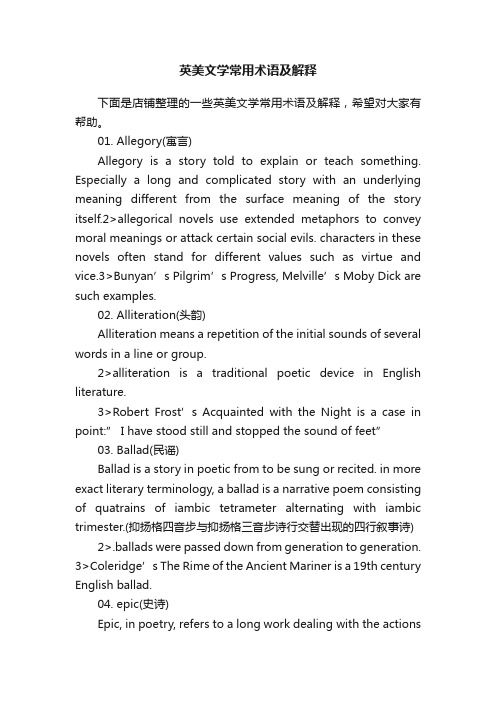
英美文学常用术语及解释下面是店铺整理的一些英美文学常用术语及解释,希望对大家有帮助。
01. Allegory(寓言)Allegory is a story told to explain or teach something. Especially a long and complicated story with an underlying meaning different from the surface meaning of the story itself.2>allegorical novels use extended metaphors to convey moral meanings or attack certain social evils. characters in these novels often stand for different values such as virtue and vice.3>Bunyan’s Pilgrim’s Progress, Melville’s Moby Dick are such examples.02. Alliteration(头韵)Alliteration means a repetition of the initial sounds of several words in a line or group.2>alliteration is a traditional poetic device in English literature.3>Robert Frost’s Acq uainted with the Night is a case in point:” I have stood still and stopped the sound of feet”03. Ballad(民谣)Ballad is a story in poetic from to be sung or recited. in more exact literary terminology, a ballad is a narrative poem consisting of quatrains of iambic tetrameter alternating with iambic trimester.(抑扬格四音步与抑扬格三音步诗行交替出现的四行叙事诗)2>.ballads were passed down from generation to generation.3>Coleridge’s The Rime of the Ancient Mariner is a 19th century English ballad.04. epic(史诗)Epic, in poetry, refers to a long work dealing with the actionsof goods and heroes.2>Epic poems are not merely entertaining stories of legendary or historical heroes; they summarize and express the nature or ideals of an entire nation at a significant or crucial period of its history.3>Beowulf is the greatest national Epic of the Anglo-Saxons.05. Lay(短叙事诗)It is a short poem, usually a romantic narrative, intended to be sung or recited by a minstrel.06. Romance(传奇)Romance is a popular literary form in the medic England.2>it sings knightly adventures or other heroic deeds.3>chivalry is the spirit of the romance.07. Alexandrine(亚历山大诗行)The name is derived from the fact that certain 12th and 13th century French poems on Alexander the Great were written in this meter.2>it is an iambic line of six feet, which is the French heroic verse.08. Blank Verse(无韵诗或素体广义地说)Blank verse is unrhymed poetry. Typically in iambic pentameter, and as such, the dominant verse forms of English dramatic and narrative poetry since the mid-16th century.09. Comedy(喜剧)Comedy is a light form of drama that aims primarily to amuse and that ends happily. Since it strives to provoke smile and laughter, both wit and humor are utilized. In general, the comic effect arises from recognition of some incongruity of speech, action, or character revelation, with intricate plot.10. Essay(随笔)The term refers to literary composition devoted to the presentation of the writer’s own ideas on a topic and generally addressing a particular aspect of the subject. Often brief in scope and informal in style, the essay differs from such fomal forms as the thesis, dissertation or treatise.11. Euphuistic style(绮丽体)Its principle characteristics are the excessive use of antithesis, which is pursued regardless of sense, and emphasized by alliteration and other devices; and of allusions to historical and mythological personages and to natural history drawn from such writers as Plutarch(普卢塔克), Pliny(普林尼), and Erasmus(伊拉兹马斯).2>it is the peculiar style of Euphues(优浮绮斯)12. History Plays(历史剧)History plays aim to present some historical age or character, and may be either a comedy or a tragedy. They almost tell stories about the nobles, the true people in history, but not ordinary people. the principle idea of Shakespeare’s history plays is the necessity for national unity under a mighty and just sovereign.13. Masques or Masks(假面剧)Masques (or Masks) refer to the dramatic entertainments involving dances and disguises, in which the spectacular and musical elements predominated over plot and character. As they were usually performed at court, often at very great expense, many have political overtones.14. Morality plays(道德剧)A kind of medic and early Renaissance drama that presents the conflict between the good and evil through allegorical characters. The characters tend to be personified abstractions of vices and virtues, which can be named as Mercy. Conscience, etc. unlike a mystery or a miracle play, morality play does notnecessarily use Biblical or strictly religious material because it takes place internally and psychologically in every human being.15.Sonnet(十四行诗)It is a lyric poem of 14 lines with a formal or recited and characterized by its presentation of a dramatic or exciting episode in simple narrative form.2>it is one of the most conventional and influential forms of poetry in Europe.3>Shakespeare’s sonnets are well-known.16. Spenserian Stanza(斯宾塞诗节)Spenserian Stanza is the creation of Edmund spenser.2>it refers to a stanza of nine lines, with the first eight lines in iambic pentameter(五音步抑扬格) and the last line in iambic hexameter(六音步抑扬格),rhyming ababbcbcc. 3>Spenser’s the Faerie Queen was written in this kind of stanza.17. Stanza(诗节)Stanza is a group of lines of poetry, usually four or more, arranged according to a fixed plan.2>the stanza is the unit of structure in a poem and poets do not vary the unit within a poem.18. Three Unities(三一原则)Three rules of 16th and 17th century Italian and French drama, broadly adapted from Aristotle’s Poetics<诗学>:2>the unity of time, which limits a play to a single day; the unity of place, which limits a play’s setting in a single location; and the unity of action, which limits a play to a single story line.19. Tragedy(悲剧)In general, a literary work in which the protagonist meets an unhappy or disastrous end. Unlike comedy, tragedy depicts the actions of a central character who is usually dignified or heroic.20.Conceit(奇特比喻)Conceit is a far-fetched simile or metaphor, a literary conceit occurs when the speaker compares two highly dissimilar things.2>conceit is extensively employed in John Donne’s poetry.21.Metar(格律)The word”meter” is derived from the Greek word”metron” meaning”measure”.2>in English when applied to poetry, it refers to the regular pattern of stressed and unstressed syllables.3>the analysis of the meter is called scansion(格律分析)22. University Wits(大学才子)University Wits refer to a group of scholars during the Elizabethan Age who graduated from either oxford or Cambridge. They came to London with the ambition to become professional writers. Some of them later became famous poets and playwrights. They were called” University Wits”23.Foreshadowing(预兆)Foreshadowing, the use of hints or clues in a novel or drama to suggest what will happen next. Writers use Foreshadowing to create interest and to build suspense.method used to build suspense by providing hints of what is to come.24. Soliloquy(独白)Soliloquy, in drama, means a moment when a character is alone and speaks his or her thoughts aloud..2>the line“to be, or no t to be, that is the question”, which begins the famous soliloquy from Shakespeare’s Hamlet.25.Narrative Poem(叙述诗)Narrative Poem refers to a poem that tells a story in verse,2>three traditional types of narrative poems include ballads,epics, metrical romances.3>it may consist of a series of incidents, as John Milton’s paradise lost.26.Robin Hood(罗宾.豪)Robin hood is a legendary hero of a series of English ballads, some of which date from at least the 14th century.2>the character of Robin Hood is many-sided. Strong, brave and intelligent, he is at the same time tender-hearted and affectionate.3>the dominant key in his character is his hatred for the cruel oppression and his love for the poor and downtrodden.4>another feature of Robin’s view is his reverence for the king, Robin Hood was a people’s hero.27. Beowulf(贝奥武甫)Beowulf, a typical example of old English poetry, is regarded as the greatest national epic of t he Anglo-Saxons. 2>the epic describes the exploits of a Scandinavian hero, Beowulf, in fighting against the monster Grendel, his revengeful nother, and a fire-breathing dragon in his declining years. While fight against the dragon, Beowulf was mortally wounded, however, he killed the dragon at the cost of his life, Beowulf is shown not only as a glorious hero but also as a protector of the people.28. Baroque(巴罗克式风格)This is originally a term of abuse applied to 17th century Italian art and that of other countries. It is characterized by the unclassical use of classical forms, in a literary context; it is loosely used to describe highly ornamented verse or prose, abounding in extravagant conceits.这原本是用来指17世纪的意大利艺术和其他国家艺术滥用的一个术语.这种风格主要是指对古典形式的非古典运用.在文学领域,这种风格松散地用来指十分雕饰的,大量运用奇思妙想的诗歌或散文.29. Cavalier poets(骑士派诗人)A name given to supporters of Charles I in the civil war. These poets were not a formal group, but all influenced by Ben Jonson and like him paid little attention to the sonnet. Their lyrics are distinguished by short lines, precise but idiomatic diction, and an urbane and graceful wit.30. Elegy(挽歌)Elegy has typically been used to refer to reflective poems that lament the loss of something or someone, and characterized by their metrical form.31. Restoration Comedy(复辟时期喜剧)Restoration Comedy, also the comedy of manners, developed upon the reopening of the theatres after the re-establishment of monarchy with the return of Charles II.. Its predominant tone was witty, bawdy, cynical, and amoral. Standard characters include fops, bawds, scheming valets, country squires, and sexually voracious young widows and older women. The principle theme is sexual intrigue, either for its own sake or for money.复辟时期的喜剧,又称社会习俗讽刺喜剧,是在查理二世君主复辟后剧院重新开业的基础上发展起来的,其主要的基调是诙谐,淫秽,挖苦和非道德.标准的角色包括花花公子,鸨母,诡计多端的仆人,乡绅,性欲旺盛的年轻寡妇和老女人.主要的主题是奸情,有的是为了性,有的是为了钱.。
戏剧翻译_精品文档

② Simple sentence structure
Example: 常四爷:是呀,您的眼力不错!戊戌年我就在这说了句“大清国
要完”,叫您二位给抓了走,坐了一年多的牢! 宋恩子:您的记性可也不错!混得还好吧?
—老舍《茶馆》
Chang: Yes, you have a good memory. In 1898 I made the remark here, “the Great Qing Empire is about done for!” For that I was arrested by you two, and imprisoned for more than a year!
All literature is made up of words, but dramas are made up of spoken words. (所有的文学都由文字组成,但戏剧是由口语 化的文字组成)
--- Boulton (戏剧研究学家)
To Achieve Colloquialism
① incomplete sentences Incomplete and simple sentences help to establish the playwright’s colloquial style. If the translator wants to keep this style, he must make the characters speak simple language in his translation.
◆ one language to another (difficulties of idiom, slang, tone, style, irony, word-play or puns)
Theatre & Drama戏剧词汇

英语词汇-戏剧 TheatreAbsurdism 荒诞派(戏剧)Act 剧中的一幕Aisle (座位中的)走道Announcer / Master of ceremonies 报幕员Antagonist 反面人物。
Applause 喝采,鼓掌Apron 台口(舞台大幕前面的区域)。
Arena Stage 中心式舞台、圆形舞台、包围式舞台。
Art director 艺术指导Aside 旁白Audience / Spectators 观众Audition 试演Auditorium 礼堂Avant-garde 先锋、前卫(戏剧)Back Light 背光Backdrop 背景幕布Backstage 后台Balcony 三层楼座Beijing / Peking opera 京剧Black-box Theatre 黑匣子剧场Blocking 舞台调度Broadway 百老汇Box 包厢Box-office / Ticket office 售票处Business 舞台上人物的细节动作,又称Stage businessCallback (选演员过程中的)复试Casting 分派角色Catharsis 情感净化、宣泄Character 剧中人物Chief / leading actress 女主角Chief / leading actor 男主角Chorus 歌队Cinema 电影院;某种题材的电影Climax 高潮Cloakroom 衣帽间Comedy 喜剧Commedia dell’Arte 即兴喜剧Company / Troupe 剧团Concert hall 音乐厅Costume 服装Convention 戏剧惯例、程式Critics 评论家Critique 评论,批判Cross Fade (灯光)暗转Cue 提示暗号,Q 点Cue Sheet 提示表,节目进行表Curtain 幕Curtain Call 谢幕Day show matinee 日场Denouement 结局,收场Dimmer 调光器Director 导演Downstage 舞台前部Drama 戏剧艺术,注意和Theatre 的区别Dramatic action 戏剧行动Dress circle 楼厅(二楼)前座Dress rehearsals 彩排Dressing room 化装室Encore! 安可!再来一次!to give an encore (演员)再来一次Ensemble 全体演员Entrance 入口Epic Theatre 史诗戏剧Episode 情节中的插曲Evening show 夜场Exit 出口Farce 闹剧,滑稽剧Farewell performance 告别演出First performance / Premiere 首次演出Flat (软)景片Focus 焦点Footlight 脚灯Found Space 非常规表演空间Gallery 顶层楼座;美术馆、展览馆Give Notes 导演给演员关于排演的反馈意见Green Room 演职员休息室Ham 过火表演,拙劣演员Historical play 历史剧House Curtain 大幕House full / Full house 客满,满座Improvisation 即兴表演Intermezzo 间奏曲Interval / Intermission 休息Kabuki 日本歌舞伎Leading role/character 主角Levels 舞台上的台阶或坡道Libretto 歌剧脚本Lines 台词Lobby / Foyer 休息室Mask 面具Make-up 化装Make-up man 化装师Melodrama 情节剧Mime 哑剧,默剧Mobile troupe 巡回演出队Monologue / Soliloquy 独白Morning show 早场Motivation 人物(行动)动机Musical 音乐剧Objective 人物的任务,目的Off-Broadway 外百老汇Off-off-Broadway 外外百老汇,实验戏剧Offstage 后台One-act play 独幕剧Open-air theatre / Amphitheatre 露天剧场Opera 歌剧Operetta 小歌剧Opera glasses 看戏望远镜Opera house 歌剧院Orchestra pit 乐池Part / role 角色Pantomime / Mime 哑剧Performance Area 表演区,也作:Acting Area Pit 正厅后座Play / Stage play 话剧Playwright 编剧,剧作家Play the role of... 扮演(某一角色)Plot 情节Possible encore 预备节目Present on the stage 搬上舞台Producer 制作人Production 作品Programme 节目单Prologue 序幕Prompt 提词Prompter 提词人Prompters’ box 提词厢Prompt Book 演出台词本Props (or properties)道具Property man 道具管理员Proscenium Stage 镜框式舞台Protagonist 主人公,主角Put on a play 演出,上演Puppet show 木偶戏Puppet show theatre 木偶剧场Read-through 对台词Refreshments room 小吃部Rehearsal 排演(rehearse动词)Repertoire 保留节目(总称)Revolving stage 旋转舞台Row 排Scene 剧中的一场Scene-man 布景员Scene-painter 布景画家Scenery / decor 布景Setting designer 布景设计人Sound effect 音响效果Stage 舞台Stage Directions 舞台提示Stage effect 舞台效果Stage illumination / lighting 舞台照明Stage manager 舞台监督Stage version 上演本Stalls 正厅前座Spotlight 聚光灯Subtext 潜台词Synopsis 剧情简介Tableau 舞台上的活人造型Tech Rehearsal 排练中偏重技术的合成阶段Tempo 演出节奏Theatre 剧场艺术,戏剧Thrust stage 伸出式舞台Title role 剧名角色Top light 顶灯Tragedy 悲剧Traditional theatrical pieces 传统剧目Upper circle 楼厅(二楼)后座Upstage 舞台后部Usher 男引座员Usherette 女引座员Walk-through 走台Xiqu / Traditional Chinese Theatre 戏曲West End, London 伦敦西区(英国著名商业戏剧区)。
浅谈Drama活动在英语课堂中的运用
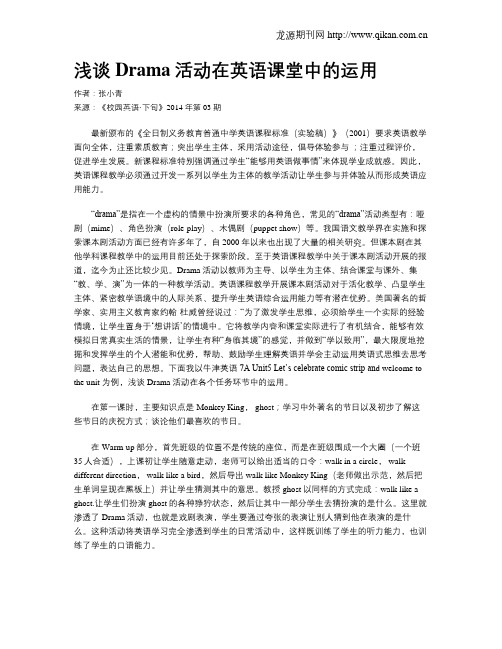
浅谈Drama活动在英语课堂中的运用作者:张小青来源:《校园英语·下旬》2014年第03期最新颁布的《全日制义务教育普通中学英语课程标准(实验稿)》(2001)要求英语教学面向全体,注重素质教育;突出学生主体,采用活动途径,倡导体验参与;注重过程评价,促进学生发展。
新课程标准特别强调通过学生“能够用英语做事情”来体现学业成就感。
因此,英语课程教学必须通过开发一系列以学生为主体的教学活动让学生参与并体验从而形成英语应用能力。
“drama”是指在一个虚构的情景中扮演所要求的各种角色,常见的“drama”活动类型有:哑剧(mime)、角色扮演(role-play)、木偶剧(puppet show)等。
我国语文教学界在实施和探索课本剧活动方面已经有许多年了,自2000年以来也出现了大量的相关研究。
但课本剧在其他学科课程教学中的运用目前还处于探索阶段。
至于英语课程教学中关于课本剧活动开展的报道,迄今为止还比较少见。
Drama活动以教师为主导、以学生为主体、结合课堂与课外、集“教、学、演”为一体的一种教学活动。
英语课程教学开展课本剧活动对于活化教学、凸显学生主体、紧密教学语境中的人际关系、提升学生英语综合运用能力等有潜在优势。
美国著名的哲学家、实用主义教育家约翰·杜威曾经说过:“为了激发学生思维,必须给学生一个实际的经验情境,让学生置身于‘想讲话’的情境中。
它将教学内容和课堂实际进行了有机结合,能够有效模拟日常真实生活的情景,让学生有种“身临其境”的感觉,并做到“学以致用”,最大限度地挖掘和发挥学生的个人潜能和优势,帮助、鼓励学生理解英语并学会主动运用英语式思维去思考问题,表达自己的思想。
下面我以牛津英语7A Unit5 Let’s celebrate comic strip an d welcome to the unit 为例,浅谈Drama活动在各个任务环节中的运用。
在第一课时,主要知识点是Monkey King, ghost;学习中外著名的节日以及初步了解这些节日的庆祝方式;谈论他们最喜欢的节日。
(完整版)英美文学史复习笔记
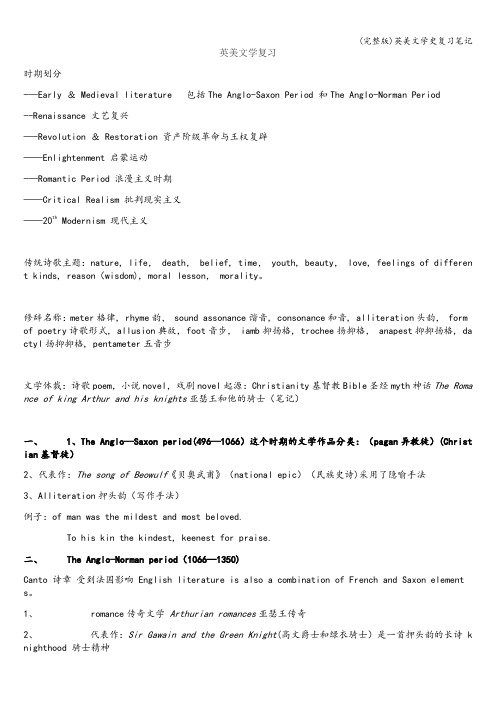
英美文学复习时期划分-—Early & Medieval literature 包括The Anglo-Saxon Period 和The Anglo-Norman Period--Renaissance 文艺复兴—-Revolution & Restoration 资产阶级革命与王权复辟——Enlightenment 启蒙运动-—Romantic Period 浪漫主义时期——Critical Realism 批判现实主义——20th Modernism 现代主义传统诗歌主题:nature, life, death, belief, time, youth, beauty, love, feelings of differen t kinds, reason(wisdom), moral lesson, morality。
修辞名称:meter格律, rhyme韵, sound assonance谐音, consonance和音, alliteration头韵, form of poetry诗歌形式, allusion典故, foot音步, iamb抑扬格, trochee扬抑格, anapest抑抑扬格, da ctyl扬抑抑格, pentameter五音步文学体裁:诗歌poem,小说novel,戏剧novel起源:Christianity基督教Bible圣经myth神话The Roma nce of king Arthur and his knights亚瑟王和他的骑士(笔记)一、 1、The Anglo—Saxon period(496—1066)这个时期的文学作品分类:(pagan异教徒)(Christ ian基督徒)2、代表作:The song of Beowulf《贝奥武甫》(national epic)(民族史诗)采用了隐喻手法3、Alliteration押头韵(写作手法)例子:of man was the mildest and most beloved.To his kin the kindest, keenest for praise.二、 The Anglo-Norman period(1066—1350)Canto 诗章受到法国影响 English literature is also a combination of French and Saxon element s。
Drama在初中英语教学中的运用3页
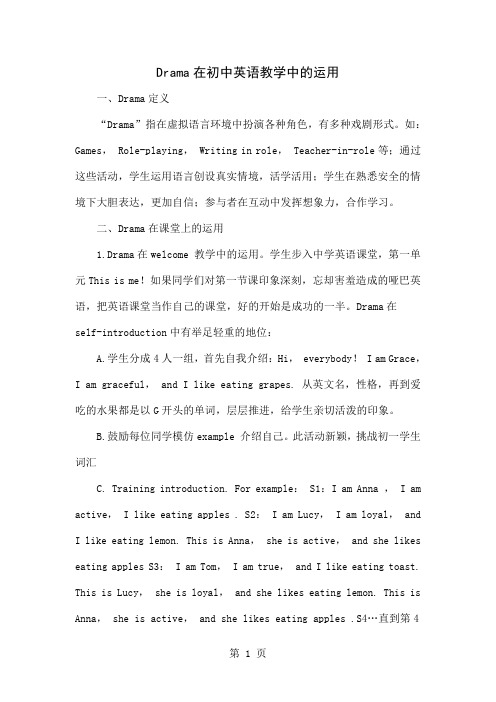
Drama在初中英语教学中的运用一、Drama定义“Drama”指在虚拟语言环境中扮演各种角色,有多种戏剧形式。
如:Games, Role-playing, Writing in role, Teacher-in-role等;通过这些活动,学生运用语言创设真实情境,活学活用;学生在熟悉安全的情境下大胆表达,更加自信;参与者在互动中发挥想象力,合作学习。
二、Drama在课堂上的运用1.Drama在welcome 教学中的运用。
学生步入中学英语课堂,第一单元This is me!如果同学们对第一节课印象深刻,忘却害羞造成的哑巴英语,把英语课堂当作自己的课堂,好的开始是成功的一半。
Drama在self-introduction中有举足轻重的地位:A.学生分成4人一组,首先自我介绍:Hi, everybody! I am Grace,I am graceful, and I like eating grapes. 从英文名,性格,再到爱吃的水果都是以G开头的单词,层层推进,给学生亲切活泼的印象。
B.鼓励每位同学模仿example 介绍自己。
此活动新颖,挑战初一学生词汇C. Training introduction. For example: S1:I am Anna , I am active, I like eating apples . S2: I am Lucy, I am loyal, and I like eating lemon. This is Anna, she is active, and she likes eating apples S3: I am Tom, I am true, and I like eating toast. This is Lucy, she is loyal, and she likes eating lemon. This is Anna, she is active,and she likes eating apples .S4…直到第4位学生把小组内每一位成员认识完。
英美文学名词解释总结
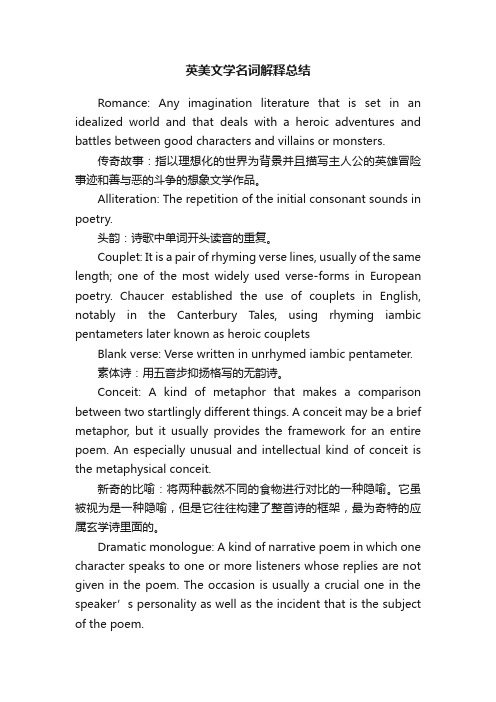
英美文学名词解释总结Romance: Any imagination literature that is set in an idealized world and that deals with a heroic adventures and battles between good characters and villains or monsters.传奇故事:指以理想化的世界为背景并且描写主人公的英雄冒险事迹和善与恶的斗争的想象文学作品。
Alliteration: The repetition of the initial consonant sounds in poetry.头韵:诗歌中单词开头读音的重复。
Couplet: It is a pair of rhyming verse lines, usually of the same length; one of the most widely used verse-forms in European poetry. Chaucer established the use of couplets in English, notably in the Canterbury Tales, using rhyming iambic pentameters later known as heroic coupletsBlank verse: Verse written in unrhymed iambic pentameter.素体诗:用五音步抑扬格写的无韵诗。
Conceit: A kind of metaphor that makes a comparison between two startlingly different things. A conceit may be a brief metaphor, but it usually provides the framework for an entire poem. An especially unusual and intellectual kind of conceit is the metaphysical conceit.新奇的比喻:将两种截然不同的食物进行对比的一种隐喻。
英美文学方向

英语专业英美文学方向✓英美戏剧Drama✓英美文学选读与欣赏Reading Course on British&American Literature✓英美小说British&American Fiction1.英美戏剧DramaWhat:This course is to develop drama appreciation ability with the introduction to basic drama concepts and learning of several classical English&American dramas.1.Definition:Drama is a composite art.It is an art made out of words.2.Elements:Plot(a beginning,middle,a climax and an end);Character;Thought;Diction;Music;Spectacle3.Three unities:The unity of action:a play should have one main actionThe unity of place:a play should cover a single physical spaceThe unity of time:the action in a play should take place less than24hours.4.Historya).From the beginning to Shakespeare–The tenth century:●the church service,the earliest English dramatic form–The fourteenth century:●Miracle play(biblical histories)(1300-1450)A dramatization of the Legend of some saint or martyr and presented either miracles performedby the saint or his relics or image,or the sufferings and death of the martyr●Morality play(religious drama)late fourteenthThe characters are for the most part personified virtues and vices and they are shown characteristically as competing for the soul of the man–The late fifteenth century,early sixteenth century:●Interlude幕间幽默短剧–The end of sixteenth century(the period of transition)●Classical drama(comedy and tragedy)b).Shakespeare and his contemporaries–the last two decades of the sixteenth century●Christopher Marlowe(Elizabethan tragedy)Doctor Faustus●William Shakespeare–the first decade of the seventeenth century●Ben Johnson The Alchemistc).Restoration and the Eighteenth century:–Comedy of manners风尚喜剧–Richard Sheridand).19th century:Oscar Wildee).20th century:Bernard ShawProblem play:Drama of social criticism discusses social,economic,or political problems by means of a play.Mrs.Warren’s Profession;Major Barbara5.Hamlet:It’s about a man called on to exact revenge for the murder of his fatherProblems:The murderer is a king;the source of the information is a ghost;the revenge must be honorable Structure:Exposition:Ghost orders revenge---Rising action:Hamlet acts mad---Climax:Hamlet does things(puts ona play,berates his mother,and kills Polonius)---Falling action:Events conspire against Hamlet while he sails toEngland---Resolution:Hamlet kills king,dies.“To be,or not to be,that is a question”---The young prince meditates upon suicide,reckons on the ills of life and concludes that man bears the burden of life only because of fears of the life to come.This famous speech performs two functions of a soliloquy:to give expression to a complicated state of mind of a character and to provide a point of view on the events of the play.6.Death of a SalesmanStyle:The play is mostly told from the point of view of the protagonist,Willy,and the previous parts of Willy's life are revealed in the form of flashback.The play's structure is a stream of consciousness.When we are in the present the characters abide by the rules of the set,entering only through the stage door to the left;however,when we visit Willy's"past"these rules are removed,with characters openly moving through walls.As Willy's mental state deteriorates,the boundaries between past and present are destroyed,and the two start to exist in parallel.Character analysis:William"Willy"Loman:The salesman.He vacillates between different perceptions of his life.Willy relies on others for support.His first name,Willy,reflects this childlike aspect as well as sounding like the question"Will he?"His last name gives the feel of Willy's being a"low man,"someone low on the social ladder and unlikely to succeed.Biff Loman:Willy's older son.He likes being outdoors and working with his hands yet wants to do something worthwhile so Willy will be proud.Overall Biff remains a realist,and informs Willy that he is just a normal guy.Harold"Happy"Loman:Willy's younger son.He's lived in the shadow of his older brother Biff most of his life and seems to be almost ignored,but he still tries to be supportive towards his family.He has a very restless lifestyle as a womanizer and dreams of moving upward.Uncle Ben:He represents Willy's idea of the American Dream success story.2.英美小说British&American FictionWhat:This course is to develop fiction appreciation ability with the appreciation of several classical English&American fictions.1.Elements of FictionsTheme;Plot;Character;Diction;Point of View2.A Rose for EmilyIt is a short story by American author William Faulkner.He was an American writer known for his novels and short stories,many of which are set in South.His common theme is the Failure and decay of the South of America.Title:a)Faulkner indicates his pity and salute...to a woman you would hand a roseb)Rose is used here as a symbol of decay and deathTheme:Resistance to changeEmily's inability to realize her father's death and refusal to adapt to a changing world intensify her solitary.Character:The protagonist Emily is protector of the tradition,and its convict,beneficiary and revolter.Diction:rich nouns and abundant adjectivesPoint of View:Multiple points of view=First-person account+third-person account3.英美文学选读与欣赏Reading Course on British&American LiteratureWhat:This course is not a major course but a public selective course.Because students of all majors might take it,it is primarily focus on the appreciation ofThe Road not to be taken1.Author:Robert Lee Frost is highly regarded for his realistic description of rural life and his command of American colloquial speech.His work frequently employed settings from rural life in New England.2.Analysis:Language:plain but meaningfulTheme:1.Choices and sequencesThe road that forks into2different directions always presents a choice to be made.The speaker would like to travel both but it is impossible.He is aware of the implications of choosing badly and does not see enough differences between the two roads.But this is the nature of life.The only way is to examine and evaluate all the details until one choice seems more appealing to the character. In this case,the speaker chooses the one less travelled.However,the choice seems to be wrong“ages and ages hence”.The"sigh"can be interpreted as regret,as this is mirrored in the regretful tone of the opening lines.It would not be right to say that choosing was the most important thing, but it is the fact that a choice has been made at all“that has made all the difference”2.A reflection of individualismIt encourages the choice of“less travelled by”,of being a loner.The Road not to be takenTwo roads diverged in a yellow wood, And sorry I could not travel bothAnd be one traveler,long I stoodAnd looked down one as far as I could To where it bent in the undergrowth;Then took the other,as just as fair, And having perhaps the better claim, Because it was grassy and wanted wear; Though as for that the passing there Had worn them really about the same,And both that morning equally layIn leaves no step had trodden black. Oh,I kept the first for another day!Yet knowing how way leads on to way, I doubted if I should ever come back.I shall be telling this with a sigh Somewhere ages and ages hence:Two roads diverged in a wood,and I—I took the one less traveled by,And that has made all the difference.British Part1.The Old and Medieval English literature(8th-14th)2.The Renaissance Period(14th-mid17th)features the essence of humanism.3.The Neoclassical Period(1660-1798)under the influence of Enlightenment Movement celebrated reason of rationality,equality and science.4.The Romanticism period(1798-1837)gave primary concern to passion,emotion,and national beauty.5.The Realism Period(1870-1914)in the Victorian Period is concerned about the fate of the common people.6.The Modern Period(1914-1945)is mainly featured by symbolism,the stream of consciousness and naturalism after theWorld War One.American Part1.The Romanticism period(1782-1859)2.The Realism Period(1870-1914)6.The Modern Period(1914-1945)Benjamin Franklin’s Autobiography is the first real American writing as well as the first real autobiography in English.Washington Irving was the first American writer who gained international fame.Ralph Waldo Emerson was regarded as leader of the movement of Transcendentalist.Ernest Hemingway is famous for his simple style and careful structuring of his fiction.。
Drama西方戏剧概说

Tragedy
The protagonist of most classical tragedies is a tragic hero. This hero
• is noble and in many ways admirable. 高贵 而令人仰慕。
• has a tragic flaw, a personal failing that leads to a tragic end. 具有可悲的弱点,个人的堕落 导致悲剧的结局。
pride
rebelliousness
jealousy
Comedy
A comedy is a play that ends happily. The plot usually centers on a romantic conflict.
boy meets girl boy loses girl boy wins girl
Music
Music refers to all of the auditory aspect of a play. 一出戏剧的所有声音效 果,包括背景音乐、合唱、动作音效等。
Spectacle 戏景
Spectacle refers to all of the visual aspects of production—scenery, lightening, costume, make-up, and the movement of the actor. 所有戏剧的视觉效果,包括布景、灯光、服装、 化妆和演员的动作。
Comedy
The main characters in a comedy could be anyone:
nobility
浅析英美文学中的戏剧性独白传统
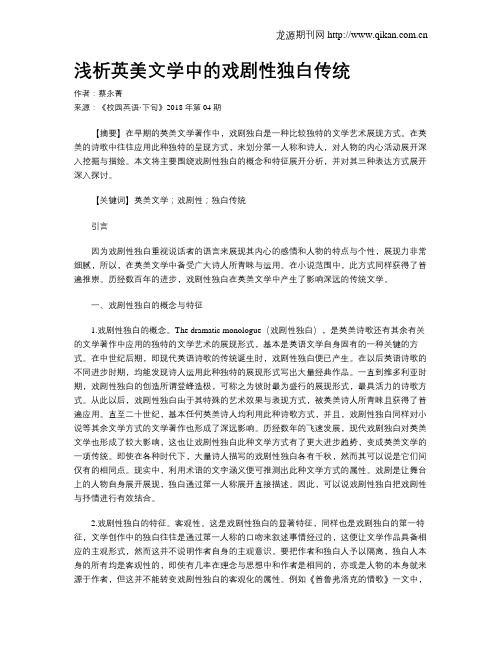
浅析英美文学中的戏剧性独白传统作者:蔡永菁来源:《校园英语·下旬》2018年第04期【摘要】在早期的英美文学著作中,戏剧独白是一种比较独特的文学艺术展现方式。
在英美的诗歌中往往应用此种独特的呈现方式,来划分第一人称和诗人,对人物的内心活动展开深入挖掘与描绘。
本文将主要围绕戏剧性独白的概念和特征展开分析,并对其三种表达方式展开深入探讨。
【关键词】英美文学;戏剧性;独白传统引言因为戏剧性独白重视说话者的语言来展现其内心的感情和人物的特点与个性,展现力非常细腻,所以,在英美文学中备受广大诗人所青睐与运用。
在小说范围中,此方式同样获得了普遍推崇。
历经数百年的进步,戏剧性独白在英美文学中产生了影响深远的传统文学。
一、戏剧性独白的概念与特征1.戏剧性独白的概念。
The dramatic monologue(戏剧性独白),是英美诗歌还有其余有关的文学著作中应用的独特的文学艺术的展现形式,基本是英语文学自身固有的一种关键的方式。
在中世纪后期,即现代英语诗歌的传统诞生时,戏剧性独白便已产生。
在以后英语诗歌的不同进步时期,均能发现诗人运用此种独特的展现形式写出大量经典作品。
一直到维多利亚时期,戏剧性独白的创造所谓登峰造极,可称之为彼时最为盛行的展现形式,最具活力的诗歌方式。
从此以后,戏剧性独白由于其特殊的艺术效果与表现方式,被英美诗人所青睐且获得了普遍应用。
直至二十世纪,基本任何英美诗人均利用此种诗歌方式,并且,戏剧性独白同样对小说等其余文学方式的文学著作也形成了深远影响。
历经数年的飞速发展,现代戏剧独白对英美文学也形成了较大影响,这也让戏剧性独白此种文学方式有了更大进步趋势,变成英美文学的一项传统。
即使在各种时代下,大量诗人描写的戏剧性独白各有千秋,然而其可以说是它们间仅有的相同点。
现实中,利用术语的文字涵义便可推测出此种文学方式的属性。
戏剧是让舞台上的人物自身展开展现,独白通过第一人称展开直接描述。
因此,可以说戏剧性独白把戏剧性与抒情进行有效结合。
- 1、下载文档前请自行甄别文档内容的完整性,平台不提供额外的编辑、内容补充、找答案等附加服务。
- 2、"仅部分预览"的文档,不可在线预览部分如存在完整性等问题,可反馈申请退款(可完整预览的文档不适用该条件!)。
- 3、如文档侵犯您的权益,请联系客服反馈,我们会尽快为您处理(人工客服工作时间:9:00-18:30)。
Origins
• Greek tragedy • Greek comedy • Medieval drama
Division
• Full length plays (acts, scenes) • One-act plays
Staging
• All visual details and physical objects of play • (scenic background, props, lighting, sound, costumes, nonverbal gestures, movements of actors)
Susan Glaspell: Trifles
• Susan Glaspell 1882-1948 • Trifles (1916) Feminist play
Drama
Drama
• • • • • • • Drama Origins Division Staging Types Modern drama Susan Glaspell: Trifles
Definition
• A composition in prose or verse presenting in dialogue or pantomime a story involving conflict or contrast of character, especially one intended to be acted on the stage (soliloquy, aside)
Types
• Tragedy: portray a conflict between human beings and some superior, overwhelming force) • Comedy: a lighter form of drama primarily aiming to amuse, in which both wit and humor are utilized • Tragi-comedies: appear to be tragedies but end happily like comedies
Experiments
• Symbolist drama: stress a subjective response to life and try to present a transcendent reality • Expressionist drama: emphasize internal lives of characters and action does not proceed in a chronological sequence but rather with a mixture of the past and the present • Epic drama: distance of characters from audience, focus on societal issues, loosely connected scenes • Theatre of absurd: man’s loss of faith and identity in modern Ibsen (turning from writing plays in verse and created a series of plays in everyday language dealing with important social and moral issues) • Theme: concern the predicament of man living in the age of science and industrialization • Style: experimental in structure and techniques • Realistic drama, symbolist drama, expressionist drama, epic drama, theatre of absurd
